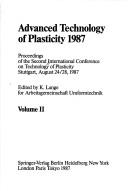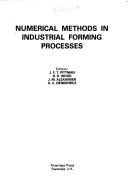| Listing 1 - 4 of 4 |
Sort by
|

ISBN: 0387179151 3540179151 9783540179153 9780387179155 Year: 1987 Publisher: Berlin Springer
Abstract | Keywords | Export | Availability | Bookmark
 Loading...
Loading...Choose an application
- Reference Manager
- EndNote
- RefWorks (Direct export to RefWorks)
Metal-work --- Metals --- Plasticity --- Congresses --- Plastic properties --- Metal-work - Congresses --- Metals - Plastic properties - Congresses --- Plasticity - Congresses
Book
ISBN: 1447142152 9786613798749 1447142160 1282056794 Year: 2012 Publisher: London : Springer,
Abstract | Keywords | Export | Availability | Bookmark
 Loading...
Loading...Choose an application
- Reference Manager
- EndNote
- RefWorks (Direct export to RefWorks)
Our knowledge of the surrounding world is obtained by our senses, of which vision is the most important for the information it can provide. In artificial systems, the field of Computer Vision aims to identify physical objects and scenes from captured images, to make useful decisions. This involves the processing and analysis of images, video data, and multi-dimensional data like medical scans. In this context, motion provides a stimulus for detecting objects in movement within the observed scene. Moreover, motion allows other characteristics to be obtained, such as object shape, speed or trajectory, which are meaningful for detection and recognition. However, the motion observable in a visual input can be due to different factors: movement of the imaged objects, movement of the observer, motion of the light sources, or a combination of these. This work focuses on motion detection from images captured by perspective and fisheye still cameras, proposing a complete sensor-independent visual system that provides robust target motion detection. First, the way sensors obtain images is studied, allowing a spatial analysis of motion to be carried out. Then, a novel background maintenance approach for robust target motion detection is implemented. Two different situations are considered: a fixed camera observing a constant background where objects are moving; and a still camera observing objects in movement against a dynamic background. This permits the development of a surveillance mechanism that removes the constraint of observing a scene free of foreground elements to obtain a reliable background model, since this situation cannot be guaranteed when operating in an unknown environment. Other problems are also addressed for the successful handling of changes in illumination, the distinction between foreground and background elements, and non-uniform vacillating backgrounds.
Metal-work -- Congresses. --- Engineering & Applied Sciences --- Applied Physics --- Detectors. --- Motion. --- Kinetics --- Sensors --- Computer science. --- Image processing. --- Computer Science. --- Image Processing and Computer Vision. --- Dynamics --- Physics --- Kinematics --- Engineering instruments --- Physical instruments --- Computer vision. --- Machine vision --- Vision, Computer --- Artificial intelligence --- Image processing --- Pattern recognition systems --- Optical data processing. --- Optical computing --- Visual data processing --- Bionics --- Electronic data processing --- Integrated optics --- Photonics --- Computers --- Optical equipment

ISBN: 0906674204 9780906674208 Year: 1982 Publisher: Swansea : Pineridge Press,
Abstract | Keywords | Export | Availability | Bookmark
 Loading...
Loading...Choose an application
- Reference Manager
- EndNote
- RefWorks (Direct export to RefWorks)
Metal-work --- Plastics --- Numerical calculations --- Congresses --- 621.74 --- -Numerical calculations --- -Plastics --- -Plastic materials --- Plastic products --- Polymers --- Synthetic products --- Condensation products (Chemistry) --- Elastomers --- Plasticity --- Numerical analysis --- Metalwork --- Decoration and ornament --- Manufacturing processes --- Metals --- Foundry work. Foundry layout and equipment. Moulding and casting --- Coloring --- -Foundry work. Foundry layout and equipment. Moulding and casting --- 621.74 Foundry work. Foundry layout and equipment. Moulding and casting --- -621.74 Foundry work. Foundry layout and equipment. Moulding and casting --- Plastic materials --- Metal-work - Congresses --- Plastics - Congresses --- Numerical calculations - Congresses
Book
ISBN: 9782708408357 2708408356 Year: 2009 Publisher: Paris Picard
Abstract | Keywords | Export | Availability | Bookmark
 Loading...
Loading...Choose an application
- Reference Manager
- EndNote
- RefWorks (Direct export to RefWorks)
Iron, Structural --- Fer de construction --- Métaux, Travail des (Architecture) --- 669.4 --- 549.261 --- Gotische bouwkunst. Architectuur van de late-Middeleeuwen --- 72.033.5 Gotische bouwkunst. Architectuur van de late-Middeleeuwen --- 549.261 Iron --- 669.4 Lead --- Métaux, Travail des (Architecture) --- Architectural metal-work --- Architecture, Gothic --- Lead --- 691.7 --- 72.033.5 --- Group 14 elements --- Metals --- Native element minerals --- Structural iron --- Building materials --- Building, Iron and steel --- Iron and steel bridges --- Steel, Structural --- Structural iron industry --- Gothic architecture --- Christian antiquities --- Church architecture --- Metal-work, Architectural --- Metal-work --- Art metal-work --- Building fittings --- 691.7 Metallic building materials --- Metallic building materials --- Iron --- Conferences - Meetings --- Architecture gothique --- Plomb --- Congresses. --- Congrès --- Architecture, Gothic - Congresses --- Lead - Congresses --- Iron, Structural - Congresses --- Architectural metal-work - Congresses
| Listing 1 - 4 of 4 |
Sort by
|

 Search
Search Feedback
Feedback About UniCat
About UniCat  Help
Help News
News